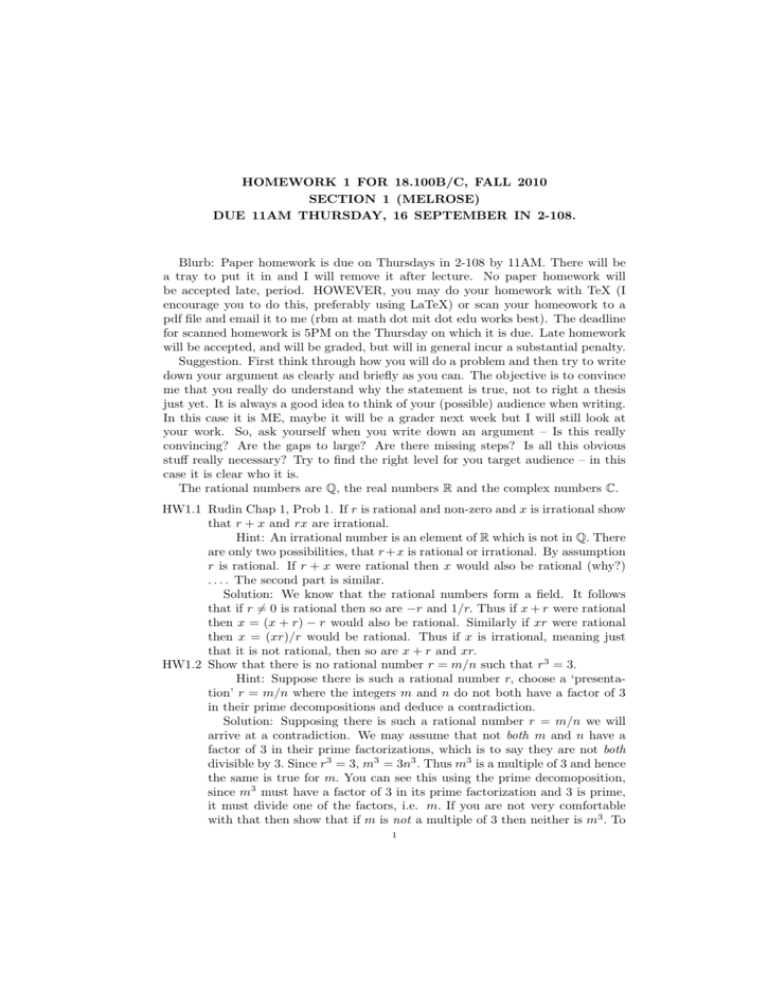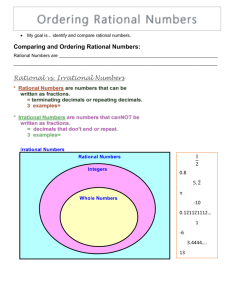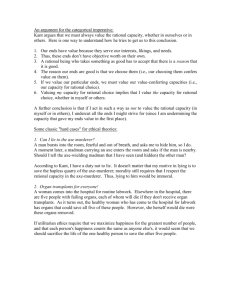Solutions to HW1
advertisement

HOMEWORK 1 FOR 18.100B/C, FALL 2010
SECTION 1 (MELROSE)
DUE 11AM THURSDAY, 16 SEPTEMBER IN 2-108.
Blurb: Paper homework is due on Thursdays in 2-108 by 11AM. There will be
a tray to put it in and I will remove it after lecture. No paper homework will
be accepted late, period. HOWEVER, you may do your homework with TeX (I
encourage you to do this, preferably using LaTeX) or scan your homeowork to a
pdf file and email it to me (rbm at math dot mit dot edu works best). The deadline
for scanned homework is 5PM on the Thursday on which it is due. Late homework
will be accepted, and will be graded, but will in general incur a substantial penalty.
Suggestion. First think through how you will do a problem and then try to write
down your argument as clearly and briefly as you can. The objective is to convince
me that you really do understand why the statement is true, not to right a thesis
just yet. It is always a good idea to think of your (possible) audience when writing.
In this case it is ME, maybe it will be a grader next week but I will still look at
your work. So, ask yourself when you write down an argument – Is this really
convincing? Are the gaps to large? Are there missing steps? Is all this obvious
stuff really necessary? Try to find the right level for you target audience – in this
case it is clear who it is.
The rational numbers are Q, the real numbers R and the complex numbers C.
HW1.1 Rudin Chap 1, Prob 1. If r is rational and non-zero and x is irrational show
that r + x and rx are irrational.
Hint: An irrational number is an element of R which is not in Q. There
are only two possibilities, that r +x is rational or irrational. By assumption
r is rational. If r + x were rational then x would also be rational (why?)
. . . . The second part is similar.
Solution: We know that the rational numbers form a field. It follows
that if r 6= 0 is rational then so are −r and 1/r. Thus if x + r were rational
then x = (x + r) − r would also be rational. Similarly if xr were rational
then x = (xr)/r would be rational. Thus if x is irrational, meaning just
that it is not rational, then so are x + r and xr.
HW1.2 Show that there is no rational number r = m/n such that r3 = 3.
Hint: Suppose there is such a rational number r, choose a ‘presentation’ r = m/n where the integers m and n do not both have a factor of 3
in their prime decompositions and deduce a contradiction.
Solution: Supposing there is such a rational number r = m/n we will
arrive at a contradiction. We may assume that not both m and n have a
factor of 3 in their prime factorizations, which is to say they are not both
divisible by 3. Since r3 = 3, m3 = 3n3 . Thus m3 is a multiple of 3 and hence
the same is true for m. You can see this using the prime decomoposition,
since m3 must have a factor of 3 in its prime factorization and 3 is prime,
it must divide one of the factors, i.e. m. If you are not very comfortable
with that then show that if m is not a multiple of 3 then neither is m3 . To
1
2
HOMEWORK 1 FOR 18.100B/C, FALL 2010 SECTION 1 (MELROSE)
DUE 11AM THURSDAY, 16 SEPTEMBER IN 2-108.
do so, observe that if m is not a multiple of 3 then it is either of the form
3k + 1 or 3k + 2 where k is an integer. Compute the cube and you will
see it is not divisibile by 3. So m = 3k but then n3 = 9k 3 and the same
argument applies to n which contradicts the fact that the have been chosen
not to both be multiples of 3.
HW1.3 Rudin Chap 1, Prob 4. Let E be a nonempty subset of an ordered set;
suppose α is a lower bound for E and β is an upper bound. Prove that
α ≤ β.
Hint: Look at the order relations between α, β and some element
γ ∈ E.
Solution: By definition to say that α is a lower bound for E means that
α ≤ γ for all γ ∈ E. To say that β is an upper bound for E is to say γ ≤ β
for all γ ∈ E. Since E is non-empty there is an element such that α ≤ γ ≤ β
so by the transitivity property of an order α ≤ β.√
HW1.4 Show that the real numbers of the form q1 + q2 3, where q1 and q2 are
rational, form a field. Hint: First check that the negative and inverse of
a non-zero number of this form is of the same form, then check that the
sum and product of two of these numbers is also of the same form. Then
go through the list of axioms of a field checking that they are true because
they are true for the reals.
Solution: You can use the fact that the real numbers
form a field. Let
√
F be the set of real numbers of the form q1 + q2 3. First check that F is
‘closed’ under addition and multiplication – the result of these operations
is a real number, we just need to show that it is in F. Computing directly
(1) √
√
√
√
√
√
(a+b 3)+(c+d 3) = (a+b)+(c+d) 3, (a+b 3)(c+d 3) = (ac+3bd)+(ad+bc) 3
√
where of course we have used the fact that ( 3)2 = 3. Now, the rationals
form a field so these are both elements of f. It follows that the associativity,
commutativity and distribution axioms hold for F since the hold for R. Also,
0 and 1 are in F and have the required properties since this is true in R.
So, what remains is to show the existence of additive and multiplicative
inverses. Clearly
√
√
(2)
(a + b 3) + (−a − b 3) = 0
and observe that
(3)
√
√
(a + b 3)(a − b 3) = a2 − 3b2 .
√
√
Now, we know – following the argument in class for 2 – that 3 is not
rational, which√means that the only rational solution of a2 −3b2 is a = b = 0.
Thus, if a + b 3 6= 0, which means that a and b are not both zero, then
I = a2 − 3b2 6= 0 is rational and
√
a
b√
(4)
(a + b 3)−1 = −
3
I
I
is in F. Thus, F is indeed a field.
HW1.5 Rudin Chap 2, Prob 2: A complex number z is said to be algebraic if there
are integers ai , i = 0, . . . , n, not all zero, such that
a0 z n + a1 z n−1 + · · · + an−1 z + an = 0.
HOMEWORK 1 FOR 18.100B/C, FALL 2010SECTION 1 (MELROSE)DUE 11AM THURSDAY, 16 SEPTEMBER IN 2-108.
3
Assuming the easy part of the fundamental theorem of algebra, that such
an equation can have at most n distinct solutions, prove that the set of all
algebraic numbers is countable. Rudin’s hint: For every positive integer N
there are only finitely many such equations with
n + |a0 + |a1 | + · · · + |an | = N.
Using this write the algebraic numbers as a countable union of finite sets.
Solution: We can assume that the set of solutions of any one algebraic
equation
a0 z n + a1 z n−1 + · · · + an−1 z + an = 0
(5)
is finite, provided at least one of the coefficients is non-zero. In fact there
are at most n solutions – at the end of the course we will prove that there
is always a solution (provided some aj 6= 0 with j > 0. Now, consider the
set of all (n + 2)-tuples A = {(n, a0 , . . . , an )} where n ∈ N and the aj ∈ Z
with at least one non-zero. Then A is a countable set – it is clearly not
finite and it can be written as the union
[
A=
AN , AN = {(n, a0 , . . . , an ) ∈ A; n + |a0 | + · · · + |an | ≤ N }.
N
Since each of the entries in an element of AN is bounded by in absolute value
by N, AN is finite. Thus A is countable and if we let F (n, a0 , . . . , an ) ⊂ C
be the set of solutions of (5) then the set of algebraic numbers is
[
F (n, a0 , . . . , an )
(n,a0 ,...,an )∈AN
is a countable union of finite sets hence is at most countable. All rationals
are algebriac, since the satisfy linear equations mz − n = 0 hence the set of
algebraic numbers is infinite and therefore countable.







